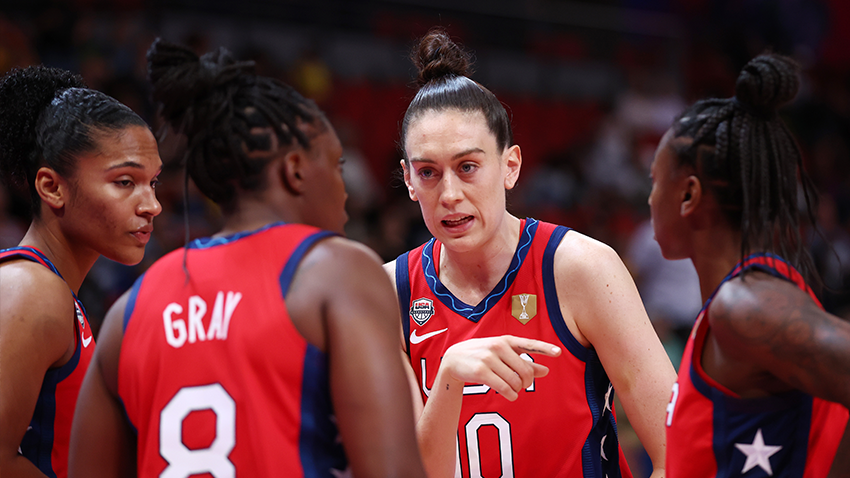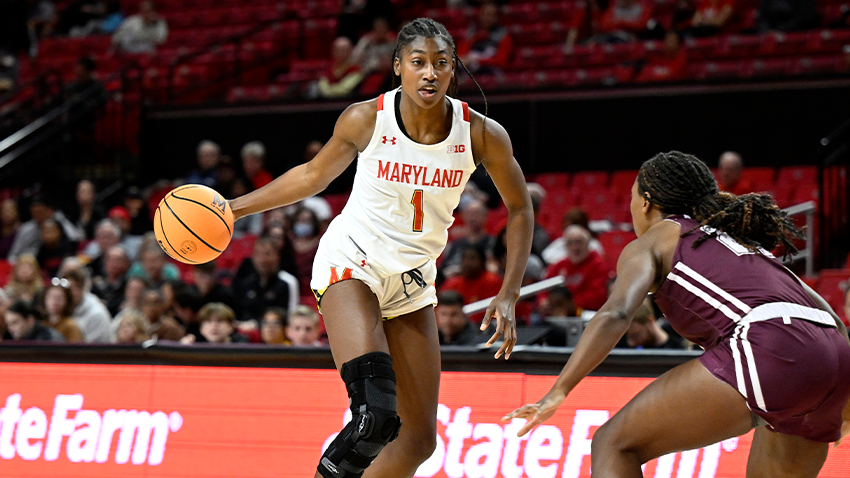Promising Prospects from the 2022 FIBA World Cup

The 2022 FIBA World Cup captivated my attention for the latter part of September, culminating in a Team USA Gold Medal, their fourth straight in the event. While that signified the continuing dominance of the United States on paper, the play was stellar across the board. Canada placed fourth, their highest finish in international play since 1986. China took home Silver, their first second-place finish since 1994. Australia, France, and Belgium all had bright moments, but varying injuries before and during the tournament took a toll.
Throughout the World Cup, prospects who are on the W’s radar flashed reason for optimism and buy-in to who they could become as players.
Shakira Austin just finished up her rookie season and contributed at a high level during FIBA as the youngest player on the USA roster. While she was lower in the rotation, she saw an extended run against Puerto Rico and Korea, showcasing her freneticism on the defensive end and running the court. Yet, her budding ability to attack and finish off the catch popped and then some; I can’t wait to see how she develops and expands her game in the coming year.
We’ve seen Austin’s game showcased, however. Who stood out at FIBA that hasn’t played in the W yet?
Mya Hollingshed, the 8th overall pick in the 2022 draft, was a standout for Puerto Rico after receiving approval from FIBA to naturalize (Here is a great article on understanding international play naturalization in basketball).
Hollingshed averaged 13 points, 6.3 rebounds, and 1.8 assists across six games, including a 29-point heater against Korea. The base of her game is built upon her jump shot, and she canned nearly 43% of her triples (4.7 per game).

She’s proficient as a stationary shooter, off of flare screens, screening, and popping, and even has mixed in a fair amount of pull-ups outside and inside the arc.

She has a solid ability to attack off the bounce when closed out on, allowing her to get to the rim straight line or drive into a post-up and use her height and release point over smaller defenders. There’s room for improvement at finishing through contact, and a tightened handle would be huge for her game.
Hollingshed has a really interesting intersection of skill and size where she’s more of a combo forward (¾) in build but with the game of a four/five. She’s best used as a screener and popper or spacer to get the most out of her skillset, but filling out a bit more and improving her functional strength feels like a significant part of her impending development.
On the defensive end, she has extremely impressive moments of help-side rim protection. She has active hands, a long wingspan, and the lateral quickness to defend a few positions and situationally switch. However, getting back to that intersection of skill and size, some of her strength concerns showed with her playing mostly at the five defensively for undersized Puerto Rico. They opted at times to utilize her to hedge ball screens or blitz entirely to prevent paint touches without funneling drivers to her at the rim.
That’s not a bad thing! Again, it’s just important to note some of the limitations in a player’s game at present to better understand where they’re headed and their potential impact. How Hollingshed’s defensive feel and awareness continue to develop will be essential for her growth as a player. Those are things that will improve steadily with more reps, and that’s what I want to see from Hollingshed.
She’s a highly intriguing prospect with a budding skillset that fits how the game continues to shift; keep Mya Hollingshed on your radar.
Sika Kone, a third-round pick in the 2022 Draft by the New York Liberty, showed out for Mali at FIBA.
Kone didn’t come over to the Liberty this season, but she just turned 20 in July, and her play at FIBA tantalized, showcasing an enticing growth track. According to InStat Scouting, Kone had taken just 13 threes across 66 games in their database before the FIBA tournament and the new Spanish season (Kone plays for Gran Canaria). She’s taken 14 in the five FIBA games and through her first game of Spanish League play. While her efficiency is low at just 28.6% from deep on 2.3 attempts per game over that frame, the development is substantial. She’s testing new waters in a meaningful way.
Kone was pretty strictly an energy player who dominated the glass and struck fear in the hearts of defenses with tenacious interior scoring. With the athleticism and coordination she possesses at 6’3, she has the ability to grow her game as a forward, and we’re seeing that play out right now.
We got to see Kone attack closeouts and take defenders off the dribble from farther out than we’ve routinely seen in her youth career.

There’s definite room for her footwork to improve. Her balance can be a bit funky and wonky, but there’s an innate ability to get into the paint which matters. Getting there is the difficult part for most, but finishing can be workshopped. She brandishes her physicality incredibly well, almost too well sometimes, as she can smother herself with contact.
The idea of what Kone can be to me is a face-up versatile frontcourt player who can spend minutes across all three positions. She has the pop to roll effectively and the physicality to be an effective screener. The shooting growth and indicators make her long strides, and stealthily quality handles a legitimate weapon.
To say she’s an outlier with her energy isn’t lacking in truth; she is fierce on the glass or for a loose ball.
It’s hard to fully ascribe who she was defensively at FIBA, as Mali’s defense was difficult to parse out. There are a lot of plays where she makes things happen with her activity and ability to cover ground, but having some of it reigned in a more concrete scheme could be really beneficial.
I can’t say for sure whether or not Kone is “ready” to play in the W, but depending on her development as the Spanish season goes on, it’s a question I imagine the Liberty will ask themselves and ponder repeatedly. Her size, athleticism, and energy are things the Liberty lacked at times this year, and she could be a game-changer for New York even in a smaller role.
Laeticia Amihere is an upcoming Senior at the University of South Carolina and played for Team Canada at FIBA. I have a much less concrete read on her than Hollingshed or Kone, but what I’ve seen has me setting notifications for SC games this winter.
At 6’4, the playmaking and floor awareness she shows is staggering. I’m a massive believer in frontcourt players who can connect plays and have a good feel for the game, and Amihere fits that billing.

She has really spectacular displays of handles, especially at her size and ability to dish the rock off the bounce. Her height is a weapon for her to see and pass over the defense, operating as a playmaking hub in the middle of the floor and connecting the dots of off-ball players with quick distributions.
Amihere’s blend of mobility, shot-blocking, and pick-and-roll defensive aptitude make her a tremendous defensive prospect. She was really able to stifle and squander WNBA level ball-handlers with her length and recovery skills, and I frankly cannot wait to see her in an even larger role with the Gamecocks this season.
The biggest thing I’m looking forward to with Amihere is how her scoring progresses. Getting the most out of a player’s playmaking ability is difficult without positive scoring gravity. Where are those shots going to come from? Can she develop more as a shooter, a driver, or a post-up player?
FIBA provided an exciting lens to watch younger prospects test their strengths and weaknesses against the top professionals in the world. Numerous players showed out in encouraging matters while showing room for growth as well.
As the season continues to near and eventually unfurl, be sure to follow along with our draft coverage at WNBA.com!
WNBA reporter Mark Schindler writes a column on WNBA.com throughout the season and can be reached on Twitter at @MG_Schindler. The views on this page do not necessarily reflect the views of the WNBA or its clubs.




,xPosition=.5,yPosition=.5)
,xPosition=.5,yPosition=.5)
,xPosition=.5,yPosition=.5)
,xPosition=.5,yPosition=.5)